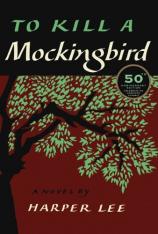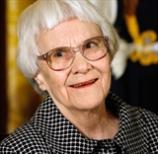Reading Group Guide
Discussion Questions
To Kill A Mockingbird: 50th Anniversary Edition

1. How do Scout, Jem, and Dill characterize Boo Radley at the beginning of the book? In what way did Boo's past history of violence foreshadow his method of protecting Jem and Scout from Bob Ewell? Does this repetition of aggression make him more or less of a sympathetic character?
2. In Scout's account of her childhood, her father Atticus reigns supreme. How would you characterize his abilities as a single parent? How would you describe his treatment of Calpurnia and Tom Robinson vis-a-vis his treatment of his white neighbors and colleagues? How would you typify his views on race and class in the larger context of his community and his peers?
3. The title of Lee's book is alluded to when Atticus gives his children air rifles and tells them that they can shoot all the bluejays they want, but "it's a sin to kill a mockingbird." At the end of the novel, Scout likens the "sin" of naming Boo as Bob Ewell's killer to "shootin' a mockingbird." Do you think that Boo is the only innocent, or mockingbird, in this novel?
4. Scout ages two years --- from 6 to 8 --- over the course of Lee's novel, which is narrated from her perspective as an adult. Did you find the account her narrator provides believable? Were there incidents or observations in the book that seemed unusually "knowing" for such a young child? What event or episode in Scout's story do you feel truly captures her personality?
5. To Kill a Mockingbird has been challenged repeatedly by the political left and right, who have sought to remove it from libraries for its portrayal of conflict between children and adults; ungrammatical speech; references to sex, the supernatural, and witchcraft; and unfavorable presentation of blacks. Which elements of the book-if any-do you think touch on controversial issues in our contemporary culture? Did you find any of those elements especially troubling, persuasive, or insightful?
6. Jem describes to Scout the four "folks" or classes of people in Maycomb County: “…our kind of folks don't like the Cunninghams, the Cunninghams don't like the Ewells, and the Ewells hate and despise the colored folks." What do you think of the ways in which Lee explores race and class in 1930s Alabama? What significance, if any, do you think these characterizations have for people living in other parts of the world?
7. One of the chief criticisms of To Kill a Mockingbird is that the two central storylines --- Scout, Jem, and Dill's fascination with Boo Radley and the trial between Mayella Ewell and Tom Robinson --- are not sufficiently connected in the novel. Do you think that Lee is successful in incorporating these different stories? Were you surprised at the way in which these story lines were resolved? Why or why not?
8. By the end of To Kill a Mockingbird, the book's first sentence: "When he was thirteen, my brother Jem got his arm badly broken at the elbow," has been explained and resolved. What did you think of the events that followed the Halloween pageant? Did you think that Bob Ewell was capable of injuring Scout or Jem? How did you feel about Boo Radley's last-minute intervention?
9. What elements of this book did you find especially memorable, humorous, or inspiring? Are there individual characters whose beliefs, acts, or motives especially impressed or surprised you? Did any events in this book cause you to reconsider your childhood memories or experiences in a new light?
To Kill A Mockingbird: 50th Anniversary Edition
- Publication Date: May 11, 2010
- Hardcover: 336 pages
- Publisher: Harper
- ISBN-10: 0061743526
- ISBN-13: 9780061743528








